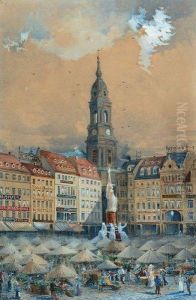Julius Heinrich Hahnel Paintings
Julius Heinrich Hahnel was a German sculptor born on September 17, 1823, in Dresden, Kingdom of Saxony. His work is often associated with the 19th-century Romantic movement, capturing the essence of neoclassicism with a distinct flair that emphasized emotion, nature, and historical subjects. Hahnel's career spanned much of the second half of the 19th century, a period that saw significant political, social, and artistic transformations in Germany and throughout Europe.
Hahnel was educated at the Dresden Academy of Fine Arts, where he studied under Ernst Rietschel, a prominent sculptor known for his influential works in Germany. This mentorship was pivotal in shaping Hahnel's artistic direction, instilling in him a deep appreciation for classical forms and the emerging Romantic ideals that sought to evoke emotion and grandeur through art. Hahnel's talent and dedication to his craft earned him recognition early in his career, allowing him to embark on travels to Italy, a common rite of passage for artists of the time, where he further immersed himself in the study of Renaissance and classical sculptures.
Throughout his career, Julius Hahnel created a variety of works, including public monuments, funerary art, and decorative sculptures. One of his most notable achievements is the design and execution of sculptures for the Dresden Opera House, showcasing his adeptness at integrating sculpture with architecture in a harmonious and compelling manner. His works are characterized by their intricate detail, emotional depth, and adherence to classical beauty, all while incorporating a sense of dynamism and movement that was a hallmark of the Romantic spirit.
Despite his successes, Julius Heinrich Hahnel remained relatively modest in his ambitions, focusing on the quality and integrity of his work rather than seeking widespread fame. He passed away on June 11, 1909, in Dresden. Today, his works continue to be admired for their technical mastery and expressive power, securing his place in the annals of 19th-century German art. Hahnel's contributions to sculpture and the broader artistic landscape of his time reflect a deep commitment to the ideals of beauty, emotion, and historical reverence that defined the Romantic era.
